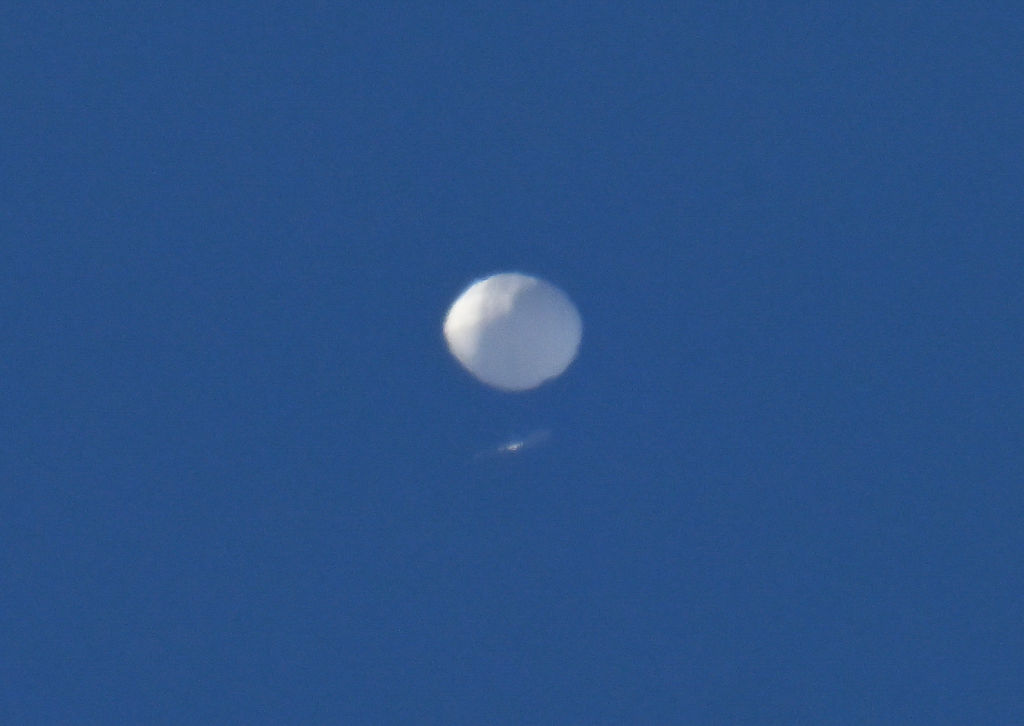After dithering for a week, the Biden administration finally shot down a Chinese high-altitude intelligence-gathering balloon. At a reported altitude of 58,000 feet, an F-22 Raptor from the 1st Fighter Wing, Langley AFB, VA, fired an AIM-9X air-to-air heat-seeker missile at the Chinese balloon. The Communist Chinese Party (CCP) airship burst open as the missile detonated. Its surveillance instrument package became a streamer and a long plummet into the ocean within the 12-mile limit off the coast of South Carolina. Why the actual shootdown took so long after identifying the balloon as Chinese and why the balloon was over the US in the first place are just some of the questions asked in the Beijing balloon caper postmortem.
Balloon Journey Timeline Makes Biden Decision-Making Questionable
 A prime-time news media network released on Sunday, February 5, a detailed timeline of the travels of the CCP spy balloon. The intelligence gathering balloon’s itinerary while in US airspace raises even more concerns. “The balloon entered US airspace on Jan. 28 north of the Aleutian Islands in Alaska, according to a senior military official,” Meredith Deliso writing for ABC News, said. And the timeline was verified by senior military officials. The balloon meandered about Alaska for two days before entering Canadian airspace on January 30. “‘On Wednesday [February 1], when I was briefed on the balloon, I ordered the Pentagon to shoot it down…as soon as possible,’ Biden told reporters in Hagerstown, MD,” The Hill Reported. So, the Chinese surveillance craft illegally entered the US and Canadian sovereign airspace and cruised at 60,000 for roughly four days before President Biden said he was briefed.
A prime-time news media network released on Sunday, February 5, a detailed timeline of the travels of the CCP spy balloon. The intelligence gathering balloon’s itinerary while in US airspace raises even more concerns. “The balloon entered US airspace on Jan. 28 north of the Aleutian Islands in Alaska, according to a senior military official,” Meredith Deliso writing for ABC News, said. And the timeline was verified by senior military officials. The balloon meandered about Alaska for two days before entering Canadian airspace on January 30. “‘On Wednesday [February 1], when I was briefed on the balloon, I ordered the Pentagon to shoot it down…as soon as possible,’ Biden told reporters in Hagerstown, MD,” The Hill Reported. So, the Chinese surveillance craft illegally entered the US and Canadian sovereign airspace and cruised at 60,000 for roughly four days before President Biden said he was briefed.
Military officials knew that the balloon entered US airspace again over Idaho on January 31. Others knew it as well. The People’s Republic of China (PRC) President Xi Jinping’s government knew it. Furthermore, there were, no doubt, PRC military analysts counting the days until the US recognized the CCP airship for what it was and took action. The PRC learned that the time between NORAD (North American Aerospace Command), including Canada and the United States, detected and identified as Chinese the data-gathering airship and started tracking it was two days.

(Photo by Peter Zay/Anadolu Agency via Getty Images)
The decision to shoot it down was another approximately two days. Forty-eight hours is glacial when considering the time of flight of an intercontinental ballistic missile (ICBM) from launch in China to impact in the US is estimated at approximately 54 minutes. Using the ICBM flight time is an extreme example, but what is the decision time horizon for the Biden administration? It surely can’t be four days. If the People’s Liberation Army (PLA) decides to invade Taiwan, the US must be more responsive. However, it may be that China’s testing of the US response time was to validate that the US would do precisely what the Biden administration did. Additionally, the Chinese were no doubt encouraged by the fact that “there was likely ‘symbolic value’ to China being able to brazenly fly a balloon over the US, even when it also has access to monitoring technology from satellites beyond the reach of the US… reminding the US that China can just conduct surveillance with impunity,’” defense researcher at Kings College London, Marina Miron told the Business Insider.
Explanation for Why Balloon Wasn’t Destroyed Sooner Draws Skepticism
When the balloon was identified as a PRC airship and questions were asked about why the balloon wasn’t shot down earlier, the explanation was that the decision was made to wait until there was no risk of debris causing damage to buildings or putting people’s lives in jeopardy. But we know back on January 28, when the balloon was detected over the Aleutian Islands and later lingered over Alaska, there were plenty of large open spaces where few, if any, people resided.
Moreover, as we now learn, the balloon was brought down after passing over the South Carolina coast before reaching the 12-mile US territorial limit. Certainly, that same amount of square acreage of unpopulated land could have been found before the balloon’s transit across the Continental US. Nonetheless, a heat-seeking Sidewinder missile, versions of which have been in the US Air Force inventory since 1956, was fired at nearly point-blank range bringing the balloon instrument bundle tumbling into 47 feet of water just off the shore of Myrtle Beach, SC.
 Balloon Shoot Down Expensive Operational Decision
Balloon Shoot Down Expensive Operational Decision
There will be those who question why a nearly $400,000 missile was used instead of the Vulcan 20 mm rotary cannon the F-22 Raptor has built into the fighter’s right wing. A burst from the plane’s cannon would have done the trick at a lot less cost. But there was no doubt a good operational rationale for the weapon selection. With the scrutiny, the mission received from just about every high-ranking official in the Air Force, Pentagon, and White House watching from packed command and control centers, the F-22 pilot did not want to record a miss preferring one shot, one kill.
Ultimately, the decision to shoot down the CCP surveillance airship was the right one. Should and could the decision have been made sooner? Probably yes. However, the entire episode painted a more troubling picture of what appeared to be the US government’s slow decision-making process. This will not be lost on the Chinese.
The views expressed are those of the author and not of any other affiliation.
Do you have an opinion about this article? We’d love to hear it! If you send your comments to [email protected], we might even publish your edited remarks in our new feature, LN Readers Speak Out. Remember to include the URL of the article along with your name, city, and state.
Please respect our republishing guidelines. Republication permission does not equal site endorsement. Click here.

